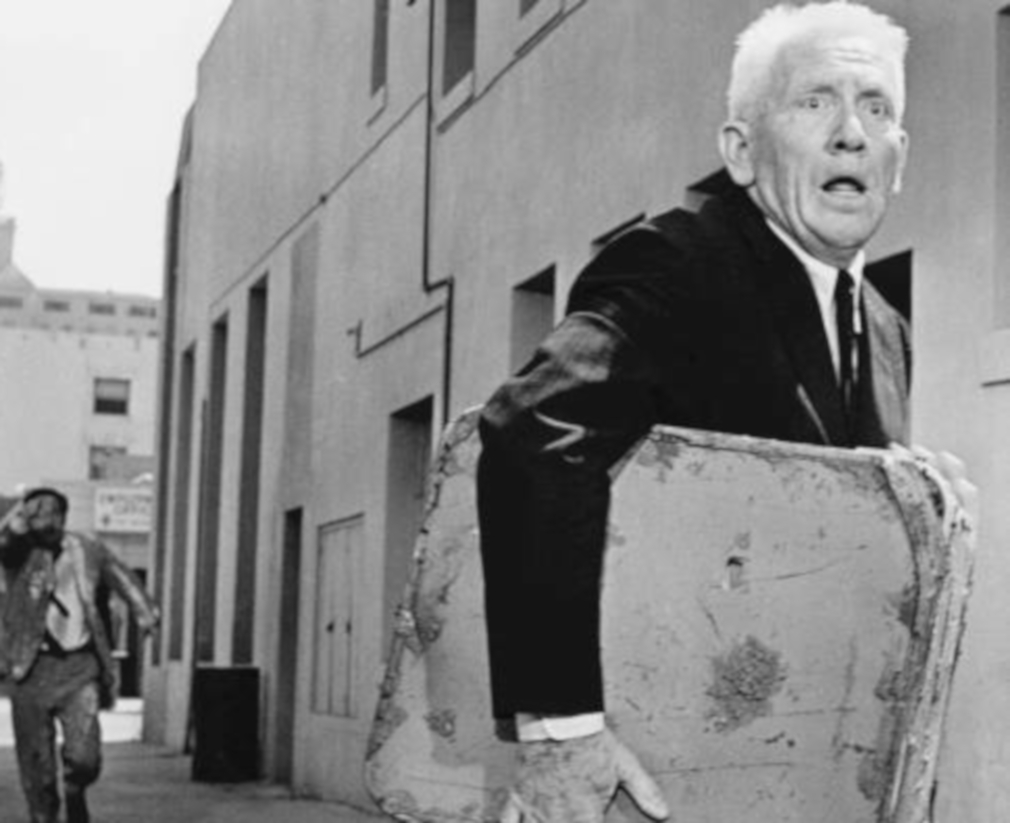UNITED STATES—Are you celebrating, now that Southern California emerges from the quarantine woods, by setting out to do something special you long ago promised yourself would do? I’d love to hear about it. Meanwhile I continue the intellectual and nostalgic journey I promised myself in the depths of COVID: a defense of the 1963 madcap comedy epic, It’s a Mad Mad Mad Mad World.
About 30 minutes, into the story of eight travelers brought together on a desert roadside by the dying words of a paroled thief who crashes and before kicking the bucket, literally, shares the secret of “350 Gs under a Big W in Santa Rosita” and thus sets off a greed-fueled race for the loot. Here is a stunning cut to activities at the Santa Rosita Police Station (on a par with the revelation that Roger Thornhill in Hitchcock’s “North by Northwest” is not a real person, but a meticulously created non-existent Cold-War agent, established through elaborately staged behavioral patterns and simulated travels).
Captain Culpepper is surveilling all the travelers, he has all their names, professions and pecadilloes all lassoed and there’s a clear sense they are being exploited as human bloodhounds to help solve a heist that’s eluded Spencer Tracy’s Captain Culpepper for 15 years.
Kramer’s film is a showcase for the Spencer Tracy’s acting greatness as well as a roster of comedy talents gathered therein. Tracy is the heart of the film, a counterweight to all the clowns’ antics. During the strenuous shoot, a frail Tracy was quite bemused with his co-actors Milton Berle, Terry-Thomas, Edie Adams, Sid Caesar, Jonathan Winters, Stan Freberg (etc. etc.). He called them “the comedians” and was delighted to be working with their likes, horses of a different color in comparison to Kathryn Hepburn, say, or Frederick March, in Inherit the Wind, a typical Stanley Kramer message vehicle.
In this case, a drama inspired by the 1925 Scopes Monkey trial that extols the miracle of ordinary human intelligence in which Spencer Tracy plays the defense lawyer based on Clarence Darrow pitted against a three-time presidential candidate Jennings Bryant in the trial of a schoolteacher accused of violating a Tennessee law that forbade the teaching of Human Evolution in publicly funded schools.
Tracy’s talent was far from self-evident from my first grade school viewing of this comic masterpiece; rather, in the course of time MMMMW launched a quest to pinpoint the reasons behind the encomia for Spencer Tracy’s widely touted gift for being “natural.”
In MMMMW, Kramer cannily taps Tracy’s believability. We identify with him, we feel for him. There are great scenes in the police station of the fictional Santa Rosita Police Station (exteriors shot in Long Beach) with fellow officer William Demarest about his pension he has coming to him. Spencer Tracy looks weary, haggard and rumpled with deep grooves in his face and a fine full head of white hair. The emotion is palpable; the talent far exceeds the ruin of a man, who is this regard project everyman.
As the three-hour movie progresses, his life unravels, his wife (a heard, but not seen Selma Diamond) wants to divorce him, his teenage daughter disowns him. Encapsulated in a scene, Captain Culpepper in shirtsleeves and on one line his daughter, on another his wife. By the end of the film, Captain Culpepper has crossed the line. Culpepper convinces the swollen group of treasure hunters to turn themselves in at the police station and pledges to “take care” of the suitcase with the $350,000 dollars stolen from a cannery payroll, he plans to drive across the border.
If his driving were a little bit better, he’d make it. I still hope he does make it when viewing this movie for the ninth or tenth time. Looking at this performance you will “get” the greatness of Tracy after a while and perhaps seek out more of his work, which stands the test of time.
Incidentally, Stanley Kramer was paying Spencer Tracy more than anybody else in the movie, all the loot in the suitcase plus fifty thousand. Eight days work, total. This great artist Tracy who is always up front about what motivated him to act: it was the loot, the dough that was a lot more than you got for digging ditches and you get the idea that he didn’t like acting a bit more than digging ditches.
He was moody and always wanting to back out. Filming had started and Mad World and he wanted to back out. He thought he was all wrong. Now this was old had for producer Kramer (Tracy’s employer for much of the last ten years of his career).
Speaking of old hats, it was Tracy’s choice to use a brown slouch hat given to him by John Ford. And the wide-brimmed hat does a lot to conjure the image of a guy cagey and holding inside an angle all his own.
Tracy was averse to filming in the heat of the Mojave, stayed in his air-conditioned trailer and wilted outdoors. In every crevasse and blotch of his face, you see the effects of sunny southern California’s harsh solar presence on a transplanted Irishman.
To be continued…






